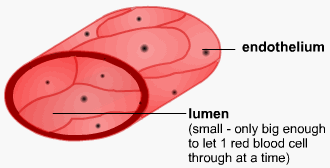正如大家所知,Alevel生物课程的难度相对于国内生物课程的难度要稍微高一些。它不仅仅体现在实验操作性强上,更在基础知识的深度和广度上。在学习的过程中,很多同学反映不知道怎么记忆那些知识点,也不知道如何将知识点运用到实践中,在写论文时更是发愁。针对这些困难,小编为大家梳理了中英对照版本的alevel生物知识点梳理,共分为三篇,同学们可持续关注获得更多资料,那么现在就一起来看看吧!
Capillaries 毛细血管

To work efficiently, the capillaries need to be small enough to be in close proximity with small groups of cells and their walls need to be thin enough to allow substances to move in and out of the blood.
To enable this there are tiny gaps between the cells making up the wall of the capillary. These allow substances to leave the blood and bathe the cells of the tissues. The fluid made up of plasma and dissolved substances is called tissue fluid.
为了有效地工作,毛细血管需要足够小,以便与小群细胞紧密相连,而且其壁需要足够薄,以允许物质在血液中进出。
为了实现这一点,在构成毛细血管壁的细胞之间有微小的缝隙。这些缝隙允许物质离开血液,沐浴在组织细胞中。由血浆和溶解物质组成的液体被称为组织液。
Tissue fluid 组织液
Tissue fluid is formed because of the high hydrostatic pressure of the blood at the arteriole end of the capillary that pushes fluid out of the blood.
组织液的形成是由于血液在毛细血管的动静脉末端的高静水压将液体从血液中挤出。
The blood contains plasma proteins giving the blood a relatively high solute potential (and therefore a low water potential), tending to draw water into the blood. Since the hydrostatic pressure has a greater effect than the solute potential at the arteriole end, the net effect is that fluid leaves the capillary. No blood cells or large proteins leave as they are too big to fit through the gaps.
血液中含有血浆蛋白,使血液具有相对较高的溶质潜能(因此水潜能较低),倾向于将水吸入血液。由于静水压力的影响大于动脉血管末端的溶质电位,所以净影响是液体离开毛细血管。没有血细胞或大的蛋白质离开,因为它们太大,无法通过缝隙。
At the venule end of the capillary, since fluid has been lost, the hydrostatic pressure of the blood is lower and the solute potential is higher. Because of this, fluid drains back into the blood. At this stage, the useful materials such as amino acids and glucose will have been taken up by the cells and the tissue fluid will now contain waste substances such as carbon dioxide and urea.
在毛细血管的静脉端,由于液体已经流失,血液的静水压较低,溶质电位较高。正因为如此,液体排回了血液中。在这个阶段,有用的物质如氨基酸和葡萄糖已经被细胞吸收了,而组织液现在含有废物,如二氧化碳和尿素。
About 90% of the fluid which leaks out of the capillaries seeps back in, the remaining 10% is returned to the blood by the lymphatic system and is called lymph. This system is made up of many blind-ending lymph vessels, which allow tissue fluid to flow into them via one way valves. These valves are large enough to allow proteins, which are too big to get into the capillaries, into the lymph vessels. If tissue fluid accumulates rather than be returned to the blood by the lymphatic system, bloating or oedema is the result.
从毛细血管渗出的液体中约有90%渗回,剩下的10%由淋巴系统返回血液,被称为淋巴。该系统由许多盲端淋巴管组成,允许组织液通过单程阀流入其中。这些阀门大到足以让太大而无法进入毛细血管的蛋白质进入淋巴管。如果组织液积聚而不是被淋巴系统送回血液,就会造成腹胀或水肿。
Blood consists of cells bathed in a liquid plasma. When this plasma leaks out of the capillaries, it is called tissue fluid. This is almost identical in composition to plasma but contains less protein molecules and no red blood cells. White blood cells can escape the capillaries into the tissue fluid. Lymph is virtually identical in composition to tissue fluid and just has a different name due to its different location.
血液由沐浴在液体血浆中的细胞组成。当这种血浆从毛细血管中漏出时,它被称为组织液。它的成分几乎与血浆相同,但含有较少的蛋白质分子,没有红细胞。白细胞可以从毛细血管漏出,进入组织液。淋巴与组织液的成分几乎相同,只是由于其位置不同而有不同的名称。
以上就是小编为大家整理的有关Alevel生物的知识点梳理,希望对大家有所帮助,祝学业有成金榜题名!如有更多有关Alevel课程辅导的需要,欢迎来联系在线客服老师,会获得更多专业的指导哦~
凡来源标注“惟世教育”均为惟世教育原创文章,版权均属惟世教育所有,任何媒体、网站或个人未经本网协议授权不得转载 链接、转贴或以其他任何方式复制、发表。未注明来源等稿件均为转载稿,如涉及版权请联系在线客服处理。
免费获得学习规划方案
已有 2563 位留学生获得学习规划方案



马上领取规划
*已对您的信息加密,保障信息安全。

 在线咨询
在线咨询
 免费通话
免费通话